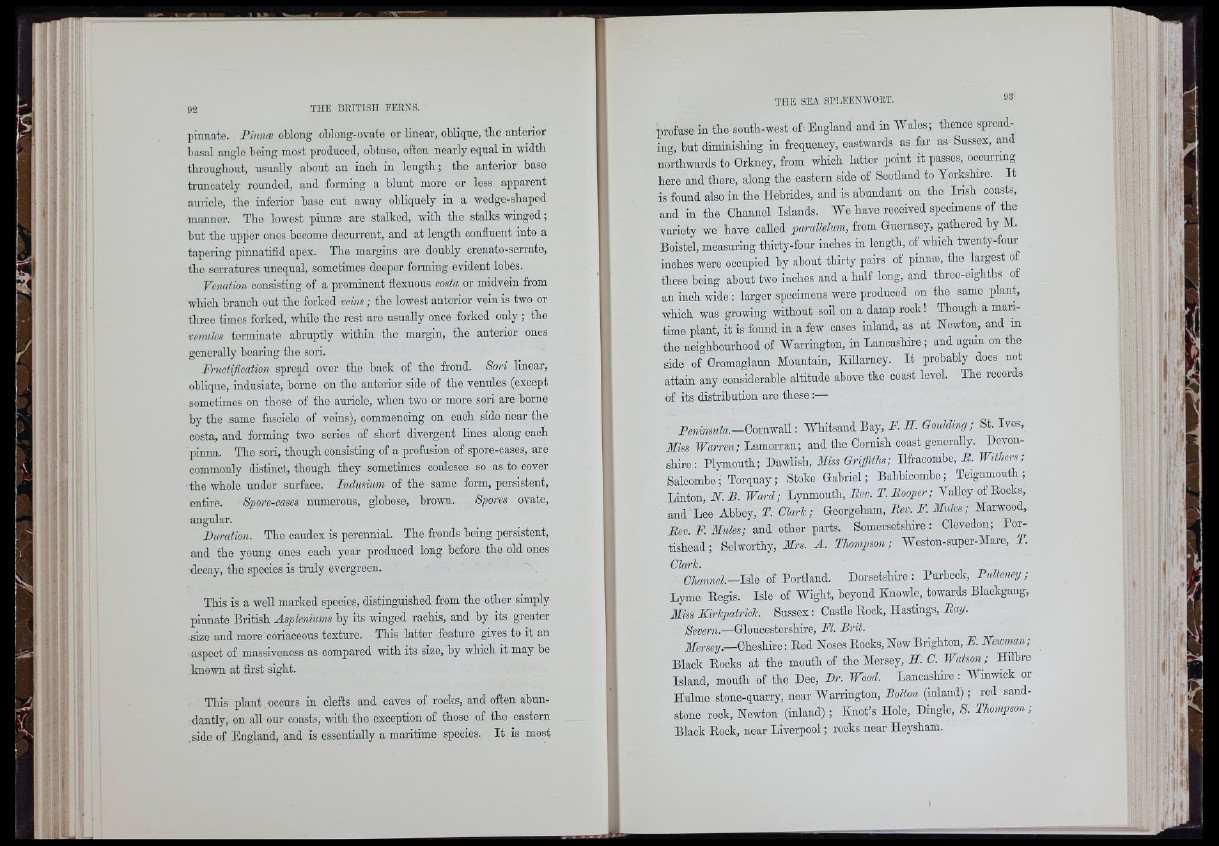
pinnate. Finnæ oblong oblong-ovate or linear, obliqne, the anterior
basal angle being most produced, obtuse, often nearly equal in width
throughout, usually about an inch in length; the anterior base
truncately rounded, and forming a blunt more or less apparent
auricle, the inferior base cut away obliquely in a wodgo-shaped
manner. The lowest pinnæ are stalked, with the stalks winged ;
hut tho upper ones become doourrent, and at length confluent into a
tapering pinnatifid apex. The margins aro doubly crenato-serrate,
the serratures unequal, sometimes deeper forming evident lobes.
Venation consisting of a prominent flexuous costa or midvein from
which branch out the forked veins ; the lowest anterior vein is two or
three times forked, while the rest are usually once forked only ; the
vcmtles terminate abruptly within the margin, the anterior ones
generally bearing the sori.
Fructification spread over the back of the frond. Sori linear,
oblique, indusiate, borne on the anterior side of the venules (except
sometimes on those of the auricle, when two or more sori are home
by the same fascicle of veins), commencing on each side near the
costa, and forming two series of short divergent lines along each
pinna. The sori, though consisting of a profusion of spore-cases, aro
commonly distinct, though they sometimes coalesce so as to cover
the whole under surface. Indusium of the same form, persistent,
entire. Spot'e-cases numerous, globose, brown. Spores ovate,
angular.
Duration. The caudex is perennial. The fronds being persistent,
and the young ones each year produced long before the old ones
decay, the species is truly evergreen.
This is a well marked species, distinguished from the other simply
pinnate British Aspleniums by its winged raohis, and by its greater
-size and more coriaceous texture. This latter feature gives to it an
aspect of massiveness as compared with its size, by which it may bo
known at first sight.
Tliis plant ooonrs in clefts and caves of rocks, and often abundantly,
on all our coasts, with the exception of those of the eastern
side of England, and is essentially a maritime species. It is most
profuse in the south-west of England and in Wales; thence spreading,
but diminishing in frequency, eastwards as far as Sussex, and
northwards to Orkney, from which latter point it passes, occurring
hero and there, along the eastern side of Scotland to Yorkshno. It
is found also in the Hebrides, and is abundant on tho Irish coasts,
and in tho Channel Islands. We have received specimens of the
variety we have caUed parallelwn, from Guernsey, gathered by M.
Boistel, measuring thirty-four inches in length, of which twenty-four
inches were occupied by about thirty pairs of pinnæ, the krgest of
these being about two inches and a half long, and thrce-oighths of
an inch wide : larger specimens were produced on the same plant,
which was growing without soil on a damp rock! Though a maritime
plant, it is found in a few cases inland, as at Howton, and in
the neighbourhood of Warrington, in LanoasHre ; and again on the
side of Oromaglaun Mountain, Killarney. It probably does not
attain any considerable altitude above the coast level. The records
of its distribution are these :—
Penvnsula.-CoxwNa\\: Whitsand Bay, F. E . Goulding; St. Ives,
Miss Warren; Lamorran; and the Cornish coast generally. Devonshire:
Plymouth; Dawlish, Miss Griffiths; Ilfracombe, R. Withers;
Saloombc; Torquay; Stoke Gabriel; Babbioombe; Teignmouth;
Linton, N. B. Ward; Lynmonth, Bev. T. Booper; VaUey of Bocks,
and Lee Abbey, T. Clark; Georgeham, Bev. F. Mules; Marwood,
iie». JP. JTiifes; and other parts. Somersetshii’e : Clevodon; Por-
tishead; Selwortby, Mrs. A. Thompson; Weston-super-Mare, T.
Clark.
G W e / .- I s l e of Portland. Dorsetshire: Bmhexk, Pultensy;
Lyme Bogis. Isle of Wight, beyond Knowle, towards Bkokgang,
Miss Kirkpatrick. Sussex: Castle Bock, Hastings, Bay.
Severn.—Gloucestershire, FI. Brit.
Mersey.—Cheshire: Bed Noses Books, New Brighton, E. Netcman;
Black Books at the mouth of the Mersey, E . C. Watson; Hilbre
Island, mouth of the Dee, Dr. Wood. Lancashire : Winwick or
Hulme stone-quarry, near Warrington, Bolton (inland); red sandstone
rook, Newton (inland) ; Knot’s Hole, Dingle, 8. Thompson;
Black Bock, near Liverpool; rocks near Heysham. i
i;5